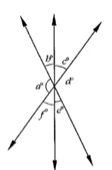Which of the following statement/statements is/are true?
I.(odd)odd=odd
II. (odd)even=even
a)Only I
b)Only II
c)Both I and II
d)Neither I nor II
The correct Answer is:A
To determine the truth of the statements provided, we need to analyze each statement step by step.
Statement I: (odd)(odd)=odd
1. Understanding the terms:
- "od d" refers to an odd number. Let's denote an odd number as x, where x can be expressed as 2n+1 for some integer n.
2. Evaluating the left side:
- We need to evaluate xx (where x is an odd number).
- The result of raising an odd number to any power (including itself) will always yield an odd number. This is because:
- Odd × Odd = Odd
- Therefore, xx will also be odd.
3. Comparing both sides:
- The left side xx is odd, and the right side is also an odd number (since odd refers to an odd number).
- Thus, we can conclude that (odd)(odd)=odd is true in the sense that both sides are odd.
Statement II: (odd)("even")="even"
1. Understanding the terms:
- Here, we are raising an odd number to an even power. Let’s denote the even power as 2m where m is an integer.
2. Evaluating the left side:
- When an odd number is raised to an even power, the result is always even. This is because:
- Odd × Odd = Odd, but when you multiply an odd number by itself an even number of times, the result is still odd.
- Therefore, (odd)("even") will yield an odd number.
3. Comparing both sides:
- The left side is odd, while the right side is "even".
- Thus, this statement is false.
Conclusion:
- Statement I is true.
- Statement II is false.
Final Answer:
- The true statement is: I only.
---
- "od d" refers to an odd number. Let's denote an odd number as x, where x can be expressed as 2n+1 for some integer n.
2. Evaluating the left side:
- We need to evaluate xx (where x is an odd number).
- The result of raising an odd number to any power (including itself) will always yield an odd number. This is because:
- Odd × Odd = Odd
- Therefore, xx will also be odd.
- The left side xx is odd, and the right side is also an odd number (since odd refers to an odd number).
- Thus, we can conclude that (odd)(odd)=odd is true in the sense that both sides are odd.
- Here, we are raising an odd number to an even power. Let’s denote the even power as 2m where m is an integer.
- When an odd number is raised to an even power, the result is always even. This is because:
- Odd × Odd = Odd, but when you multiply an odd number by itself an even number of times, the result is still odd.
- Therefore, (odd)("even") will yield an odd number.
- The left side is odd, while the right side is "even".
- Thus, this statement is false.
- Statement I is true.
- Statement II is false.
- The true statement is: I only.
Similar Questions
Knowledge Check
- Question 1 - Select One or More
Which of the following statements regarding d block elements are true?
Athe colour of anhydrous CuSO4 is blueB"spitting of silver" can be prevented by covering the surface of molten silver with charcoalCIodine liberated in a reaction can ber estimated by titration against a standard thiosulphate solutionDLanthanium is first element of third transition series - Question 2 - Select One or More
D is a 3×3 diagonal matrix. Which of the following
statements are not true?ADT=DBAD=DA for every matrix A of order 3×3CD−1 if exists is a scalar matrixDNone of the above - Question 3 - Select One
Which od the following lipid is essential part of good diet ?
AOleic acidBLinoleic acidCStearic acidDpalmitic acid.
For the integer n , if n3 is odd, then which of the following statements are true? n is odd. II. n2 is odd. III. n2 is even (a) I only (b) II only (c) I and II only (d) I and III only
View SolutionIn Figure, which of the following statements must be true? (i) a+b=d+c (ii) a+c+e=1800 (iii) b+f=c+e (a) (i) only (b) (ii) only (c) (iii) only (d) (ii) and (iii) only
 View Solution
View SolutionWhich one of the following statements is not correct about Shyamji Krishna Verma?
a) He was a native of Kutch.
b) He started a monthly journal 'Indian sociologist' .
c) He established a hostel for Indian students in London which was called 'India House'
d) He was the editor of Journal 'Ghadar'.View SolutionIn the following question below are given some statements followed by some conclusions. Taking the given statements to be true even if they seem to be at variance from commonly known facts, read all the conclusions and then decide which of the given conclusion logically follows the given statements.
Statements:
I. Some C are D.
II. Some B are C.
Conclusions:
I. Some D are C.
II. No B is DView SolutionIn the following questions, all the statements are true and find out if the given conclusion I and II are true/or not. (निम्नलिखित प्रश्नों में, सभी कथन सत्य हैं और ज्ञात कीजिए कि दिया गया निष्कर्ष I और II सत्य है या नहीं।)
Statement(कथन) : D≥B>C,C<F>I,I=Q>P
Conclusions(निष्कर्ष) : I. C=D II. P>FView Solution

